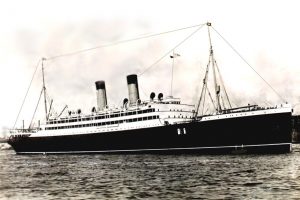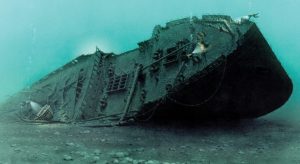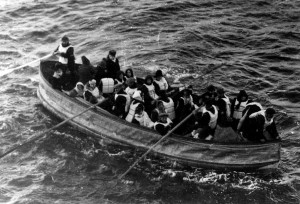sinking
 Two years after the sinking of the Titanic, the world was still very aware of the dangers of travel by ship. The Titanic was supposed to be unsinkable, and yet on April 14, 1912, it took more than 1500 people to the bottom of the Atlantic Ocean with it. Many safety precautions had changed since Titanic went down. The ship’s radio room had to be manned at all times, crews were trained extensively in emergency procedures, and ships were equipped more than enough lifejackets and lifeboats. Every precaution that they knew to take had been taken, making The Empress of Ireland one of the safest ships on Earth.
Two years after the sinking of the Titanic, the world was still very aware of the dangers of travel by ship. The Titanic was supposed to be unsinkable, and yet on April 14, 1912, it took more than 1500 people to the bottom of the Atlantic Ocean with it. Many safety precautions had changed since Titanic went down. The ship’s radio room had to be manned at all times, crews were trained extensively in emergency procedures, and ships were equipped more than enough lifejackets and lifeboats. Every precaution that they knew to take had been taken, making The Empress of Ireland one of the safest ships on Earth.
On May 29, 1914, The Empress of Ireland left Quebec Harbor on a  transatlantic journey to Liverpool England. She was sailing in heavy fog down Canada’s Saint Lawrence River, carrying 1477 passengers and crew. The Norwegian freighter Storstad was also sailing on the Saint Lawrence River on that fateful day. Sailing in heavy fog, without the modern GPS equipment to keep everyone informed of the ships’ positions, is a seriously dangerous undertaking. I don’t know that the normal protocol was for sailing in fog, but it would make sense to me that they should drop anchor and wait for the fog to lift before continuing on. I’m sure that these days, the ships would have some kind of protocol.
transatlantic journey to Liverpool England. She was sailing in heavy fog down Canada’s Saint Lawrence River, carrying 1477 passengers and crew. The Norwegian freighter Storstad was also sailing on the Saint Lawrence River on that fateful day. Sailing in heavy fog, without the modern GPS equipment to keep everyone informed of the ships’ positions, is a seriously dangerous undertaking. I don’t know that the normal protocol was for sailing in fog, but it would make sense to me that they should drop anchor and wait for the fog to lift before continuing on. I’m sure that these days, the ships would have some kind of protocol.
The Empress and the Storstad spotted each other several minutes before the inevitable collision, but altered  courses and confused signals brought them into the fateful moment of impact. I suppose that if each ship hadn’t moved in the same direction, they might have been able to avoid the collision, but unfortunately they did move in the same direction. The Storstad penetrated 15 feet into the Empress of Ireland‘s starboard side, and the vessel sunk within 14 minutes, drowning 1,012 of its passengers and crew in the Gulf of Saint Lawrence. It was one of the worst ship disasters in history. Only seven lifeboats escaped the rapidly sinking vessel, but thanks to the efforts of the crew of the Storstad, scores of survivors were pulled out of the icy waters.
courses and confused signals brought them into the fateful moment of impact. I suppose that if each ship hadn’t moved in the same direction, they might have been able to avoid the collision, but unfortunately they did move in the same direction. The Storstad penetrated 15 feet into the Empress of Ireland‘s starboard side, and the vessel sunk within 14 minutes, drowning 1,012 of its passengers and crew in the Gulf of Saint Lawrence. It was one of the worst ship disasters in history. Only seven lifeboats escaped the rapidly sinking vessel, but thanks to the efforts of the crew of the Storstad, scores of survivors were pulled out of the icy waters.
 Whenever a big train wreck, plane crash, ship sinking, or other major accident occurs, someone must investigate. Depending on what happened, it can be someone like the NTSB, or in some cases, as in the Titanic sinking, it can go as high as the Senate. Of course, answers need to be found, so that corrections in procedure can be made.
Whenever a big train wreck, plane crash, ship sinking, or other major accident occurs, someone must investigate. Depending on what happened, it can be someone like the NTSB, or in some cases, as in the Titanic sinking, it can go as high as the Senate. Of course, answers need to be found, so that corrections in procedure can be made.
In the case of the Titanic, the accident was brought before the Senate Commerce Committee. I think most of us know the story of the Titanic well, given the movies and documentaries that have come out about it. The official final report, however, went into much more detail than most people know about, and more than I can go into here. I think most of us know that the ship was not sufficiently run through the test trials to properly break in the engines. Nevertheless, the Titanic was run at full speed through trecherous waters, without regard for the damage that could have come to pass.
In addition to this problem, it was noted that many of the crew members did not join the ship until just a few hours before it sailed, and the only drill carried out, consisted of lowering just two lifeboats on the starboard side into the water. There was no boat list designating the stations members of the crew were posted to until several days after sailing. This left the crew in ignorance of their stations until the following Friday morning. Of course, as we all know, there were not enough lifeboats on the ship, because it was thought to clutter the deck, and to be unnecessary. In reality there were only boats enough for only 1,176 of the 2,228 people on board…and of those, only 710 survived, meaning that lifeboats were lowered only partially loaded. Had the Titanic been loaded to full capacity, which was 3,339 passengers and crew, there would have only been room for a third of the people on the lifeboats. and as was the case of only loading the lifeboats half full, 2,629 people would have died.
It was the conclusion of the Senate Commerce Committee, that there were several areas of gross negligence  on the part of White Star Line and the crew of the Titanic. In fact the committee was actually appalled, as it should have been. They called the Titanic, and unnecessary tragedy. Improperly trained crew and improper procedures, can be a deadly mix, and as was the case with Titanic, death is what ensued. Many laws have changed as a result of the hearings, but I have to wonder why it takes such a devastating accident to bring about a proper, concervative apporoach to the handling of many areas of transportation, construction, and work ethic. To me, it seems a little late to try to put proper safety methods in place when the ship has already sunk, but then I guess it does protect those who will come after.
on the part of White Star Line and the crew of the Titanic. In fact the committee was actually appalled, as it should have been. They called the Titanic, and unnecessary tragedy. Improperly trained crew and improper procedures, can be a deadly mix, and as was the case with Titanic, death is what ensued. Many laws have changed as a result of the hearings, but I have to wonder why it takes such a devastating accident to bring about a proper, concervative apporoach to the handling of many areas of transportation, construction, and work ethic. To me, it seems a little late to try to put proper safety methods in place when the ship has already sunk, but then I guess it does protect those who will come after.

